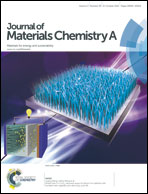Isoindigo-based low bandgap conjugated polymer for o-xylene processed efficient polymer solar cells with thick active layers†
Abstract
A low bandgap conjugated polymer, i.e., poly[2,2′-bithiophene-alt-7-fluoro-N,N′-bis(2-octyldodecyl)isoindigo] (P(1FIID-BT)), was synthesized. The polymer was soluble in non-chlorinated solvents such as o-xylene and mesitylene, and exhibited a film optical bandgap of 1.61 eV as calculated from the absorption onset and a deep highest occupied molecular orbital (HOMO) energy level of −5.46 eV as measured by an electrochemical method. Remarkably high mobilities of 0.33 and 0.42 cm2 V−1 s−1 were obtained for organic field-effect transistors (OFETs) based on pristine and annealed films, respectively. Inverted polymer solar cells (PSCs) were fabricated with phenyl-C61-butyric acid methyl ester (PC61BM) as the acceptor material and o-xylene as the processing solvent. The device efficiency was insensitive to the thickness of the active layer, and all devices with film thickness in the range of 105–340 nm showed a power conversion efficiency (PCE) higher than 6.5%. The devices based on 270 nm thick films displayed the highest performance with a VOC of 0.89 V, a JSC of 14.50 mA cm−2 and a FF of 0.58, leading to a PCE of 7.46%. This is the first low bandgap conjugated polymer for PSCs which combine three features: non-chlorinated solvent processability, high efficiency and insensitivity of efficiency to the active layer thickness.


 Please wait while we load your content...
Please wait while we load your content...